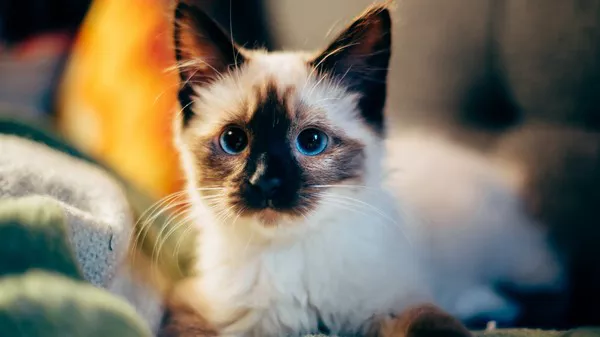Siamese cats are renowned for their striking appearance, characterized by their sleek, slender bodies, striking blue almond-shaped eyes, and distinctive color points. However, along with their unique beauty, Siamese cats have been associated with a peculiar trait: crossed eyes. This belief has persisted for generations, leading many to wonder if Siamese cats are indeed born cross-eyed. In this article, we delve into the science behind Siamese cat genetics and anatomy to dispel the myth of cross-eyed Siamese cats.
Understanding Siamese Cat Genetics
To comprehend the prevalence of crossed eyes in Siamese cats, it is essential to first understand the genetics that govern their distinctive appearance. The characteristic color points of Siamese cats are a result of a temperature-sensitive enzyme, tyrosinase, which affects the production of pigment in their fur. This enzyme is less active in cooler areas of the body, such as the extremities, resulting in darker fur in these regions.
The gene responsible for the Siamese coloration is a form of partial albinism known as the Himalayan gene. This gene inhibits the production of pigment in warmer areas of the body, allowing the characteristic color points to develop. However, the same gene can also affect the development of the optic nerve, which plays a crucial role in vision.
The Link Between Siamese Cats and Crossed Eyes
The misconception surrounding crossed eyes in Siamese cats stems from the observation that some Siamese kittens appear to have crossed eyes shortly after birth. However, it is crucial to distinguish between true strabismus (crossed eyes) and a phenomenon known as convergent strabismus.
Convergent strabismus, also referred to as medial strabismus or “cross-eyed look,” is a temporary condition commonly observed in Siamese kittens. This condition occurs due to the incomplete development of the eye muscles, particularly those responsible for controlling eye movement. As a result, the eyes may appear to be misaligned, giving the impression of crossed eyes. However, this condition typically resolves as the kitten grows and the eye muscles strengthen.
True strabismus, on the other hand, is a permanent misalignment of the eyes and can occur in cats of any breed, including Siamese. This condition may be congenital or acquired and can significantly impact the cat‘s vision. However, it is essential to recognize that true strabismus is not exclusive to Siamese cats and is not inherently linked to their breed.
Factors Contributing to Misconceptions
Several factors contribute to the perpetuation of the myth of crossed eyes in Siamese cats. One such factor is anecdotal evidence from cat owners and breeders who may have observed convergent strabismus in Siamese kittens. While these observations are valid, they often lack scientific rigor and may lead to generalizations about the breed as a whole.
Furthermore, the prevalence of crossed eyes in Siamese cats may be exacerbated by selective breeding practices aimed at emphasizing certain physical traits, including the distinctive head shape and eye appearance. These breeding practices, while intended to preserve the breed standard, may inadvertently increase the likelihood of genetic abnormalities, including ocular issues.
Dispelling the Myth Through Science
Despite the persistence of the myth, scientific evidence suggests that crossed eyes are not inherent to the Siamese breed. A study published in the Journal of Feline Medicine and Surgery found no significant association between breed and the prevalence of strabismus in cats. Instead, the study identified factors such as genetics, trauma, and neurological conditions as potential causes of strabismus in cats.
Additionally, advancements in veterinary ophthalmology have enabled researchers to better understand the underlying mechanisms of ocular conditions in cats, including strabismus. Through techniques such as electroretinography and genetic testing, veterinarians can diagnose and manage ocular disorders more effectively, improving the quality of life for affected cats.
See Also:How Long Do Snowshoe Siamese Cats Live?
Promoting Responsible Breeding Practices
While the myth of crossed eyes in Siamese cats may persist, responsible breeders play a crucial role in mitigating its prevalence. By prioritizing the health and welfare of their breeding stock, breeders can reduce the incidence of genetic abnormalities, including ocular conditions. This includes screening breeding cats for hereditary diseases and avoiding excessive inbreeding, which can increase the risk of genetic defects.
Furthermore, educating prospective cat owners about the true nature of ocular conditions in Siamese cats can help dispel misconceptions and promote informed decision-making when choosing a pet. By providing accurate information about the breed’s characteristics and potential health concerns, breeders and veterinarians can empower cat owners to make responsible choices for their feline companions.
Conclusion
In conclusion, the belief that Siamese cats are born cross-eyed is a myth perpetuated by anecdotal evidence and misconceptions about the breed. While some Siamese kittens may exhibit convergent strabismus, this condition is typically temporary and resolves as the kitten matures. True strabismus, while possible in Siamese cats, is not exclusive to the breed and can occur in cats of any breed or mix.
By understanding the genetics and anatomy of Siamese cats, as well as promoting responsible breeding practices, we can dispel myths surrounding ocular conditions in this beloved breed. Through scientific research and education, we can ensure that Siamese cats are recognized not for their supposed crossed eyes, but for their unique beauty, intelligence, and affectionate nature.
Related Topics:
How Long Do Male Siamese Cats Live?
Are Siamese Cats Bigger Than Normal Cats?
How Big Do Male Siamese Cats Get?


























